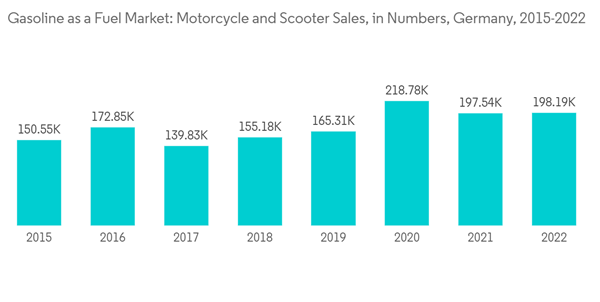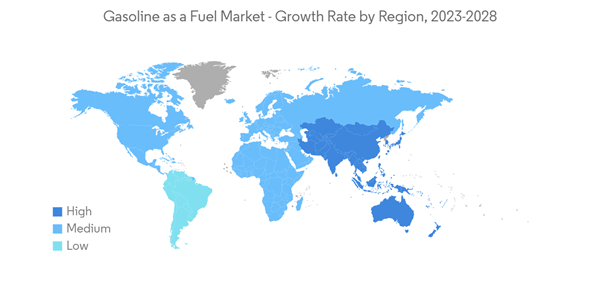Key Highlights
- Over the medium term, factors such as the rising adoption of automobiles such as passenger cars and motorcycles across the world and the easy availability of gasoline are driving the growth of gasoline as a fuel market during the forecast period.
- On the other hand, the use of alternative clean sources of energy to reduce carbon emissions and the increasing penetration of electric vehicles across the globe is likely to restrain the growth of the market.
- Nevertheless, the emerging use of portable gasoline generators in home and event applications is anticipated to create ample opportunities for gasoline as a fuel market in the near future.
Gasoline as a Fuel Market Trends
Transportation Segment is Expected to Dominate in the Market
- In order to operate smoothly and efficiently, the transportation sector requires a considerable amount of energy. Most vehicles require secondary fuels such as gasoline, diesel, or jet fuel. Primary fuels such as crude oil or natural gas are converted into usable fuels through the use of technology.
- As one of the most used fuels in automobiles, gasoline is a petroleum-based fuel designed for engines with four to six cylinders, which are found in many cars. Gasoline offers numerous advantages to automobile drivers. Due to its high combustibility, gasoline-powered vehicles tend to start up faster than those powered by other fuels. Compared to other fuels, gasoline accelerates much more quickly.
- Further, two-wheelers are widely available worldwide, with varying demand levels and popularity across various regions. Further, two-wheelers are widely used for personal transportation in countries such as China, India, Indonesia, Vietnam, Thailand, and several other Asian countries.
- According to the Society of Indian Automobile Manufacturers (SIAM), a total of 19.45 million two-wheelers were produced in India during the fiscal year 2023, with a growth rate of 9.1% from the previous year, and further, the two-wheeler production represented around 75% of all automobiles produced in the FY 2023.
- Further, Europe also witnessed significant growth in automobile sales. According to Industrieverband Motorrad e.V., there was a total of 198,193 new registrations for motorcycles and scooters in Germany in 2022, with a growth rate of 0.33% from the previous year.
- Hence, demand for gasoline as a fuel is expected to increase in the transportation segment across the globe over the forecast period.
North America to Dominate the Market
- North America is one of the largest markets in terms of capital expenditure in the oil and gas industry, with the United States being the leader, followed by Canada and Mexico. The United States is a major crude oil and natural gas producer in the world, and the country is expected to cover around 60% of the world's oil demand in the coming years.
- The United States is one of the leading countries in the North American region, where automobile sales were around 1,42,30,324 in 2022. Among these, cruise and sports bikes are the prominent ones, as in the United States, motorcycles are mostly used for long tours and sports purposes rather than just for commute purposes.
- Over the years, the country witnessed growth in the number of bike sales, especially in the private and commercial sectors. As per the US Department of Transportation, as of 2021, the private and commercial motorcycle sales were around 9.8 million, an increase of around 18% compared to the previous year. The growth in sales of motorcycles is likely to continue in the private sector during the upcoming years, which would create demand for gasoline fuel.
- Most single-cylinder engines used in motor vehicles are fueled by gasoline. Single-cylinder engines in the United States are primarily used in water pumps and soil ramming machines. Both these pieces of equipment are majorly used in construction sites. Hence, an increase in commercial, industrial, and road infrastructure construction would create ample demand for single-cylinder engines in the United States, thus driving the growth of the gasoline as a fuel market
- Construction sector in the United States contributed around 3.9% of the total GDP in 2022. The industry grew over the years due to the expansion in the commercial and household areas. The residential sector witnessed the highest growth in recent years, followed by the non-residential. As per the Construction Association, in 2022, the United States residential sector witnessed the highest investment of around USD 910 billion, while non-residential sectors (including private and public) witnessed an investment of around USD 888 billion (USD 534 billion private, and USD 355 billion public).
- Gasoline is the dominant transportation fuel in the North America. With growing transport and construction segment in the region drives the market growth.
Gasoline as a Fuel Industry Overview
The gasoline as a fuel market is fragmented. Some of the major key players in the market (in no particular order) include Chevron Corporation, Exxon Mobil Corporation, PetroChina Company Limited, Qatar Petroleum, and Reliance Industries Ltd., among others.Additional Benefits:
- The market estimate (ME) sheet in Excel format
- 3 months of analyst support
This product will be delivered within 2 business days.










